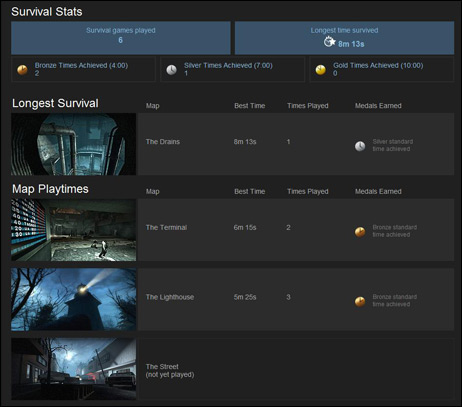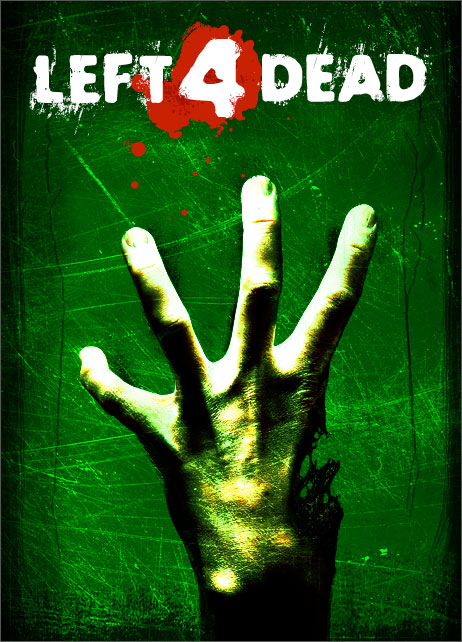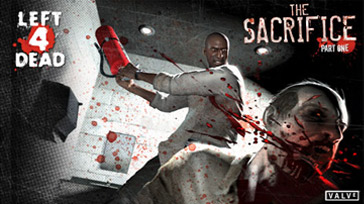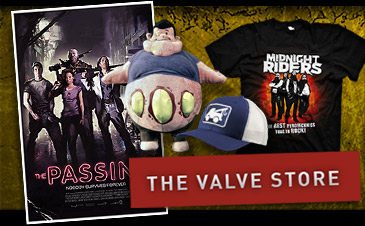17600 In-game now on Steam



Left 4 Dead, by the Numbers
April 30, 2009 - Charlie Burgin
Valve has always seen the value in gathering real-world gameplay data and using it to improve our products. Now we're hoping you'll find it as useful as we do. With the creation of the L4D stats page, our customers will now be able to see a wide variety of gameplay data across all of Left 4 Dead's various game modes.
Use the stats page to track your performance; see which aspects of your gameplay are improving over time, which are your go-to weapons, and how often you use various characters and features.
You can also use your stats page to compare your statistics against other players, giving you a quick and easy way to see how your accomplishments measure up to your friends and find players at your own skill level. You can also track negative statistics (like damage dealt to other teammates, for example), giving you a good idea of which players to avoid.
The stats page is broken up into four different pages: Overview, Weapons, Versus and Survival.
Overview
The Overview page contains an at-a-glance breakdown of your overall gameplay stats: your most recent game data; favorite characters; favorite level one and level two weapon; and how often you use and share pain pills and first aid kits. You can also see your total games played, finales survived, and the total number of zombies you have killed so far.

Weapons
The Weapon page displays your usage of the various weapons available in Left 4 Dead. For each weapon you use in-game, you can see the number of shots fired; your total kills with that weapon; your head shot total; accuracy; and percentage of kills.

Versus
The Versus page shows how often you play as each of the playable zombies in Left 4 Dead, and how well you perform with each. For every zombie type you can track your average life span; the most damage dealt in a single life; and the number of special attacks you did successfully. Additionally, you'll be able to tally the number of Versus games played you've played to date; the number of games completed; and the highest Survivor Team Score you've obtained.

Survival
The Survival page tracks your best time; the number of times you've played, and your medal level, if any, for each of the Survival maps. You can also track your overall Survivor progress, with a running tally of your total medal count for each medal type, as well as your absolute best time for any map.

We just made the L4D stats pages live, so check it out for yourself. The stats have been collected since 12/12/08 with weapons stats tracking beginning 2/11/09.
Don't forget, the Free 24 hours of Left 4 Dead starts tonight at Midnight GMT (8pm ET) and yes, free players will have their stats> collected.
To help infect your friends, the PC version of Left 4 Dead is 40% off this entire weekend on Steam, making it only $24 in North America.
DLC Released! New L4D swag at The Valve Store.
April 22, 2009 - L4D Team
We just released the DLC on the PC and 360. This includes the new Survival Mode, The Lighthouse Survival map, and 2 new Versus campaigns. To celebrate the release of the DLC we have cooked up a few items for the Valve Store.
First up is a poster for the new campaign included in Survival Mode - The Last Stand. Bill and the gang are in front of the lighthouse fighting until their dying breath. And no, it doesn't end well.
If you are looking for something to wear to celebrate the DLC we have two new items: The Zombie Skull Hoodie, and a new Horde Shirt featuring Zoey and Louis.
Finally, something even Francis couldn't hate: a CEDA coffee mug. Perfect for keeping your keep your caffeine warm as you fight zombies late into the night.
Surviving the L4D Survival Pack
April 16, 2009 - Kerry Davis and Scott Dalton
Survival Mode pits your team against never ending waves of infected. Sounds simple. Just trap the survivors in a small part of a map, unleash the hordes, and record the longest time. Survival Mode, which will be released next week, is actually a bit more than that.
Our goals for Survival Mode are to deliver a mode of play distinct from Campaign or Versus, have games that regularly last under ten minutes, and emphasize competition with team play through leaderboards.
Survival Mode draws on the planning and communication aspects of a successful Finale or Crescendo event, while taking it to another level. It rapidly hits a fever pitch that only a well coordinated team will be able to successfully survive. Everything from simply covering a reviving teammate, to making every shot count to minimize reloads becomes crucial in Survival Mode.
Given the importance of pacing in Survival Mode, we need to define as precisely as possible how the difficulty ramps up during the course of a round. We have numerous variables to work with: mob spawn frequency, special infected spawn frequency, number of each type of special infected, total number of special infected, tank spawn frequency, total number of tanks, and so on. We need all of these variables to work together to create a fairly smooth difficulty curve.
If the curve ramps up too sharply, we find that teams of all skill levels tend to hit a wall at the same time. There isn't enough variation in the times to separate great teams from average ones. If the curve is too flat, then average teams will have a good experience, but really good teams can grind on long enough to cross the line from having fun to just getting worn out.
It might seem that just gradually increasing spawn rates and numbers of infected will create a nice smooth curve, but it turns out to be much trickier than that. Each type of infected has its own spawn schedule, so even though the individual spawn curves may be designed to be fairly easy at a particular point in time, sometimes they overlap in just such a way that the players find themselves in a really bad situation far earlier than we intend.
For example, a tank will be much harder to fight if a mob of common infected spawns at the same time - and nearly impossible if three hunters also show up right at that moment. A similar situation can happen due to variables outside our control - a team may not dispatch a tank or mob quickly enough, causing subsequent waves to start arriving and piling on to an already difficult battle. It's also hard to anticipate when teams will need to make an ammo run or heal up, both of which can be extremely difficult only a few minutes into the round. In order to help visualize these overlap points and the collapse of each spawn curve, we graphed out the wave behavior of infected over the course of a survival round.

The last variable we added was the "lull" - a short interval of time during which nothing new will spawn. Each lull gets slightly longer as the round progresses, but that's no guarantee the team will actually see the lull - it just prevents new infected from spawning. It doesn't help with infected that are already in the arena. Killing mobs and tanks as quickly as possible is the best way to ensure that a team can take advantage of a lull to heal, resupply ammo, or just move to a better location with more supplies.
Given the extreme pace of Survival Mode, the number of zombies killed in a single round often outnumbers an entire campaign. Even optimizing towards using pistols to eliminate common hordes, ammunition usually becomes an issue at some point. As ammo piles provide a unique infinite resupply for players, they tend to be in relatively less defensible positions in the Survival arenas. This means making an all important ammo run is rarely a safe proposition and requires good teamwork and planning. Timing your resources correctly to be able to make a run when necessary can make or break a team. The perfect pipebomb or well placed molotov can mean the difference between a cakewalk and catastrophe.
The Hospital Elevator, for example, might seem like an easy Crescendo Event to conquer. Hit the elevator button and holdout until the doors open for a quick escape. In Survival Mode, however, the area begins locked down. Areas open as the hordes come in, breaking down the doors to reach the survivors. In each room there are additional caches of vital pills, pipes, and Molotovs. By moving from location to location, using up the plentiful supplies as needed, a team can maximize their time in a game where the elevator never arrives to offer escape. In other maps, items may be less plentiful and require careful planning on their usage. Managing one's inventory and resources works hand-in-hand with teamwork in Survival Mode.
Next week you will be able to see our design in action when the DLC is released for the PC and 360.
Lose the Thumb: Creating Left 4 Dead's Box Art
April 9, 2009 - Jeremy Bennett
Hello. My name is Jeremy Bennett, and I'm an artist at Valve. Most gamers only ever get to see the finished product of a game cover, so we thought some of you might find it interesting to hear the process that led to Left 4 Dead's final art. As you'll see, there were quite a few attempts along the way, all of them eventually abandoned.
Our first designs focused on Bill, Louis, Francis and Zoey, the four lead characters that players would be guiding through Left 4 Dead's post-apocalyptic zombie wasteland. Right away this presented problems.
Typically, for a video game (or DVD or book) cover to be eye-catching, there'll be a single prominent element front and center—our "hero" character, for example, with ancillary characters standing around in the background:

As a multiplayer game with an emphasis on teamwork, though, Left 4 Dead didn't really have a central character. Pretending otherwise, we decided, was just misleading—if the box art is selling a different game than the one in the box, it's not doing its job.
So a lead character filling up the front of a game box was out. Next we tried spacing the four characters out at equal size. On the plus side, this avoided any confusion about one character being more prominently featured (and thus more "important") than the others:

On the minus side, giving four characters equal space made them all quite small, wasting a lot of valuable box real estate without doing the one thing good box art is supposed to do: catch the eye.
Magnifying the problem was the fact that there wasn't much point to having our four heroes standing around in a void. To give the box art any sort of context to the game inside, we needed zombies. So we were faced with the unpopular idea of shrinking our heroes down even more to cram some zombies into the picture:

These attempts did a good job of capturing the multiplayer aspect of L4D, not to mention the intensity of the gameplay experience. But when viewed from a distance—by someone walking through a game store and spotting it on a shelf, for instance—it just looked like cluttered noise. The individual elements were too small and varied to communicate anything visually interesting.
Box art featuring the title of the game as the prominent feature ended up in the same category. The idea behind this typographic approach was that if the characters had to be small, we should make sure the game's title was as prominent as possible:

Unfortunately, this ran up against the same problems. Box art that's all text doesn't grab the eye, no matter how stylishly it's laid out. More importantly, it didn't feel like it was in the right "world"—put simply, it just didn't look like a game box.
After a visit to a local GameStop, it didn't take us long to realize the black, red and white color palette wasn't helping us much either. Red on black is a very attention-grabbing color scheme, and this fact wasn't lost on our competition. Scanning the shelves, we noticed a large number of game boxes already using similar color schemes in an attempt to draw the eye. But the effect, ironically, when viewed from a step back, was the opposite of the one intended—it was overwhelming.
That meant red was out now, too. Experiments with different colors, as well as research into classic zombie posters, eventually led us to green, which wasn't getting used a lot, and moreover suggested something rotting and gangrenous. This seemed perfectly in line with the "zombie panic" messaging we were hoping to get across.
We had further success once got away from the clutter of our various "Survivors vs. Zombies" attempts, focusing on the simple idea of selling the idea of "four" itself in an iconic, visually compelling way. At some point the idea sprung up of a hand—its thumb chewed off by zombies, with only four fingers left—and it stuck.

All of the noise instantly evaporated. Suddenly we had this horrific, easily graspable image, visible from far away, that managed to get across the core concepts of the game all in one go: Zombies. Four. Danger.
We had a cover we were happy with. Now it was time to put it to the test. The same local-area GameStop kindly let us conduct a few impromptu tests, printing out some of the above samples onto game boxes and placing them in various strategic positions. Then we simply hung out in the store for an afternoon, watching customers, and seeing which of the boxes grabbed people's eyes. Our instincts were on the money: The green hand art won hands-down.
But as it turned out, it still wasn't perfect—the final piece of the puzzle would actually arrive from a helpful fan. We had by this point shown off the new branding at E3, and it had only taken one fan about three seconds to point out that if we used a four-fingered left hand instead of a right hand, we could get a nice pun, with all three words of the game's title presented visually.
Happy to admit our mistake if it meant making it better, the game box was again retooled, arriving at the design on the box you see today:

A Match Made In Zombie Heaven
April 1, 2009 - Zoid
In a recent update for L4D on the PC, we provided the option for players to choose between starting a game on an Official server or the Best Available. This is just the first step in giving players control over what servers they play on and the type of experience they have.

This is part of the L4D SDK rollout, which is currently in a closed beta and will be released shortly after the launch of the L4D Survival Pack.
To support the SDK, we are extending the matchmaking system to allow for third party campaigns. We will be adding extra features so players will be able to find dedicated servers running the campaigns they have installed. They will also be able to see friends playing third party campaigns, and be directed to download them as necessary. Another major feature we are planning to add to the matchmaking system at a future date is team-based Versus matching. This will allow two teams of four to locate each other and compete in a Versus match.
We are also revamping our player matching based on skill level. Currently the system tries to match people with the same skill level and best pings together. We will be revisiting this system to tweak it based on data we have collected.
For next week's blog post, we are going to look at the process of creating the box art.






